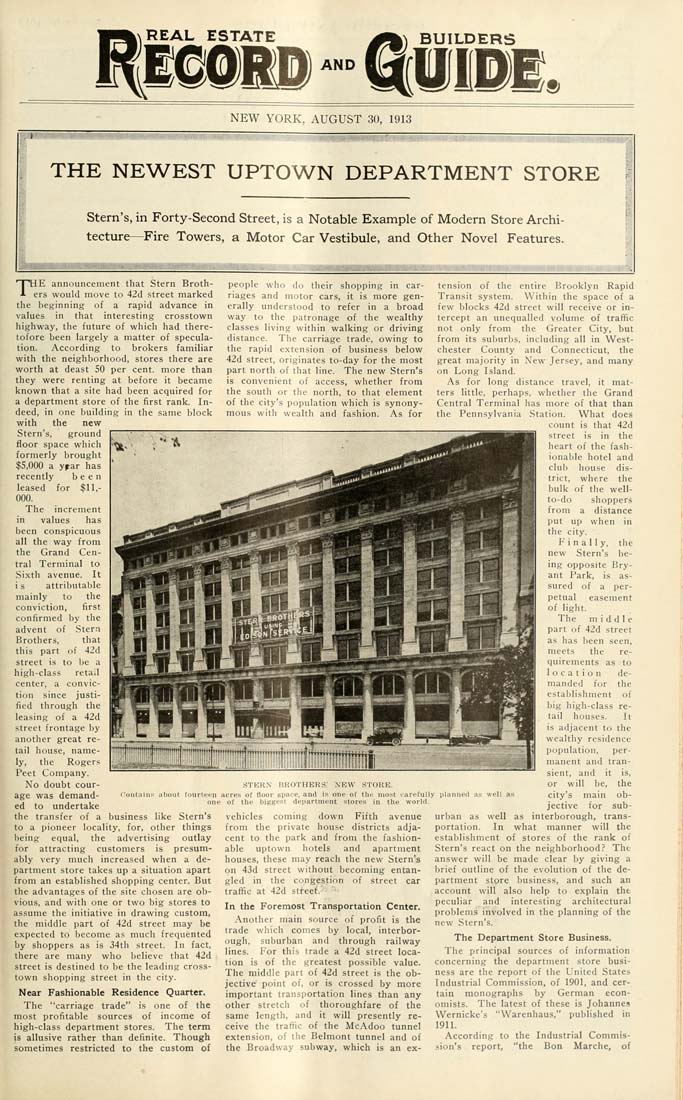Please note: this text may be incomplete. For more information about this OCR, view
About OCR text.
REAL ESTATE
AND
NEW YORK, AUGUST 30, 1913
■■■■■■■^^
■iiiiiiiMiiniiiiiiHl
THE NEWEST UPTOWN DEPARTMENT STORE
Stern's, in Forty-Second Street, is a Notable Example of Modern Store Archi- I
tecture—Fire Towers, a Motor Car Vestibule, and Other Novel Features. ■
M
lllllllllllllllllllillMllllllllllllillli
THE announcement that Stern Broth¬
ers would move to 42d street marked
the beginning of a rapid advance in
values in that interesting crosstown
highway, the future of which had there¬
tofore been largely a matter of specula¬
tion. According to brokers familiar
with the neighborhood, stores there are
worth at deast 50 per cent, more than
they were renting at before it became
known that a site had been acquired for
a department store of the first rank. In¬
deed, in one building in the same block
with the new
Stern's, ground
floor space which
formerly brought
$5,000 a y^ar has
recently been
leased for $11,-
000.
The increment
in values has
been conspicuous
all the way from
the Grand Cen¬
tral Terminal to
Si.xth avenue. It
i s attributable
mainly to the
conviction, first
confirmed by the
advent of .SteDi
Brothers, that
this part of 42d
street is to be a
high-class reta,l
center, a convic¬
tion since justi¬
fied through the
leasing of a 42d
street frontage by
another great re¬
tail house, name¬
ly, the Rogers
Peet Company.
No doubt cour¬
age was demand¬
ed to undertake
the transfer of a business like Stern's
to a pioneer locality, for, other things
being equal, the advertising outlay
for attracting customers is presum¬
ably very much increased when a de¬
partment store takes up a situation apart
from an established shopping center. But
the advantages of the site chosen are ob¬
vious, and with one or two big stores to
assume the initiative in drawing custom,
the middle part of 42d street may be
expected to become as much frequented
by shoppers as is 34th street. In fact,
there are many who believe that 42d
street is destined to be the leading cross-
town shopping street in the city.
Near Fashionable Residence Quarter.
The "carriage trade" is one of the
most profitable sources of income of
high-class department stores. The term
is allusive rather than definite. Though
sometimes restricted to the custom of
people who do their shopping in car¬
riages and motor cars, it is more gen¬
erally understood to refer in a broad
way to the patronage of the wealthy
classes living within walking or driving
distance. The carriage trade, owing to
the rapid extension of business below
42d street, originates to-day for the most
part north of that line. The new Stern's
is convenient of access, whether from
the south or the north, to that element
of the city's population which is synony¬
mous with wealth and fashion. As for
STBlt-X" liUOTHERS' XEW STOUK.
about fourteen acres of floor Bpaoe. and is one of the most carefully planned as well as
one of the biggest department stores in the world.
vehicles coming down Fifth avenue
from the private house districts adja¬
cent to the park and from the fashion¬
able uptown hotels and apartment
houses, these may reach the new Stern's
on 43d street without becoming entan¬
gled in the congestion of street car
traffic at 42d street.
In the Foremost Transportation Center.
.Another main source of profit is the
trade which comes by local, interbor¬
ough, .suburban and through railway
lines. For this trade a 42d street loca¬
tion is of the greatest possible value.
The middle part of 42d street is the ob¬
jective point of, or is crossed by more
important transportation lines than any
other stretch of thoroughfare of the
same length, and it will presently re¬
ceive the traffic of the McAdoo tunnel
extension, of the Belmont tunnel and of
the Broadway subway, which is an ex¬
tension of the entire Brooklyn Rapid
Transit system. Within the space of a
few blocks 42d street will receive or in¬
tercept an unequalled volume of traffic
not only from the Greater City, but
from its suburbs, including all in West¬
chester County and Connecticut, the
great majority in New Jersey, and many
on Long Island.
As for long distance travel, it mat¬
ters little, perhaps, whether the Grand
Central Terminal has more of that than
the Pennsylvania Station. What does
count is that 42d
street is in the
heart of the fash¬
ionable hotel and
club house dis¬
trict, where the
bulk of the well-
to-do shoppers
from a distance
put up when in
the city.
Finally, the
new Stern's be¬
ing opposite Bry¬
ant Park, is as¬
sured of a per¬
petual easement
of light.
The middle
part of 42d street
as has been seen,
meets the re¬
quirements as to
location de¬
manded for the
establishment of
big high-class re¬
tail houses. 11
is adjacent to the
wealthy residence
population, per¬
manent and tran¬
sient, and it is,
or will be, the
city's main ob¬
jective for sub¬
urban as well as interborough, trans¬
portation. In what manner will the
establishment of stores of the rank of
Stern's react on the neighborhood? The
answer will be made clear by giving a
brief outline of the evolution of the de¬
partment store business, and such an
account will also help to explain the
peculiar and interesting architectural
problems involved in the planning of the
new Stern's.
The Department Store Business.
Tlie principal sources of information
concerning the department store busi¬
ness are the report of the United States
Industrial Commission, of 1901, and cer¬
tain monographs by German econ¬
omists. The latest of these is Johannes
Wernicke's "Warenhaus," published in
1911.
According to the Industrial Commis¬
sion's report, "the Bon Marche, of








